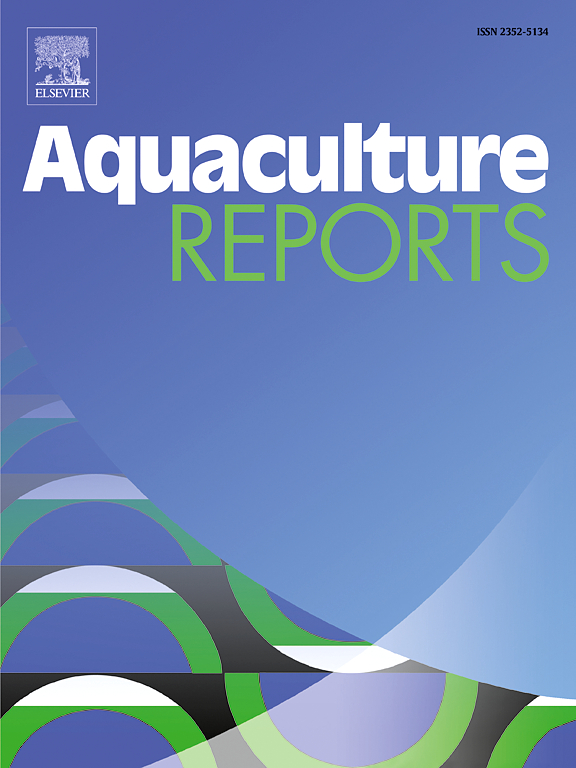Effects of Astragalus membranaceus by-product on pellet quality, mold growth and resistance of Crucian carp (Carassius auratus) against Aeromonas hydrophila
IF 3.7
2区 农林科学
Q1 FISHERIES
引用次数: 0
Abstract
This study investigated the effects of Astragalus membranaceus by-product (AP) on feed quality, mold growth, and fish disease-resistant ability. Seven fish diets were prepared with gradient levels of AP (0, 1.0, 2.0, 4.0, 8.0, 16 and 32 %). A total of 420 juvenile Crucian carp (7.17 ± 0.05 g) were randomly assigned and fed for 60 days. Results showed that AP supplementation decreased pellet hardness, and increased pellet durability index, as well as inhibited mold growth of pelleted fish feed (P<0.05). Fish weight gain (WG), feed efficiency (FE), content of reduced glutathione, and the activity of anti-hydroxy radical and anti-superoxide anion, as well as enzymes such as trypsin, amylase, alkaline phosphatase, Na+/K+-ATPase, superoxide dismutase, glutathione reductase, lipase, and glutathione-S-transferase in fish digestive organs were all improved (P<0.05), while malonaldehyde levels were decreased by dietary AP supplementation (P<0.05). The optimal AP supplementation levels for Crucian carp were 1.02 % and 1.03 %, as determined by broken-line regression analysis of WG and FE. Furthermore, dietary AP supplementation decreased the mortality of crucian carp after challenge with A. hydrophilia and increased lysozyme activity, and levels of total amino acids and protein in the plasma, and decreased content of ammonia, and activities of glutamate-oxaloacetate transaminase and glutamate-pyruvate transaminase in the plasma (P<0.05). Our study suggested that AP supplementation improves feed quality and inhibites mold growth. The beneficial of AP on fish growth performance may be associated with improved absorption and digestion. Dietary inclusion of AP enhanced non-specific immunity and antioxidant status so as to improve fish disease-resistant ability.
黄芪副产物对鲫鱼颗粒品质、霉菌生长及对嗜水气单胞菌抗性的影响
研究了黄芪副产物(AP)对饲料品质、霉菌生长和鱼类抗病能力的影响。分别配制7种不同AP水平(0、1.0、2.0、4.0、8.0、16和32% %)的鱼粮。选取幼鲫420尾(7.17 ± 0.05 g),饲喂60 d。结果表明:添加AP降低了颗粒硬度,提高了颗粒耐久性指数,抑制了颗粒鱼饲料的霉菌生长(P<0.05)。饲粮添加AP可提高鱼体增重(WG)、饲料效率(FE)、还原性谷胱甘肽含量、抗羟基自由基和抗超氧阴离子活性以及胰蛋白酶、淀粉酶、碱性磷酸酶、Na+/K+- atp酶、超氧化物歧化酶、谷胱甘肽还原酶、脂肪酶、谷胱甘肽-s转移酶等酶的活性(P<0.05),降低丙二醛水平(P<0.05)。通过对WG和FE的折线回归分析,确定了鲫的最佳AP添加水平为1.02 %和1.03 %。此外,饲粮中添加AP降低了嗜水单胞菌攻毒后鲫鱼的死亡率,提高了血浆溶菌酶活性、总氨基酸和蛋白质水平,降低了血浆氨含量、谷氨酸-草酰乙酸转氨酶和谷氨酸-丙酮酸转氨酶活性(P<0.05)。本研究表明,添加AP可提高饲料质量,抑制霉菌生长。AP对鱼类生长性能的益处可能与促进吸收和消化有关。饲料中添加AP可提高鱼的非特异性免疫和抗氧化能力,从而提高鱼的抗病能力。
本文章由计算机程序翻译,如有差异,请以英文原文为准。
求助全文
约1分钟内获得全文
求助全文
来源期刊

Aquaculture Reports
Agricultural and Biological Sciences-Animal Science and Zoology
CiteScore
5.90
自引率
8.10%
发文量
469
审稿时长
77 days
期刊介绍:
Aquaculture Reports will publish original research papers and reviews documenting outstanding science with a regional context and focus, answering the need for high quality information on novel species, systems and regions in emerging areas of aquaculture research and development, such as integrated multi-trophic aquaculture, urban aquaculture, ornamental, unfed aquaculture, offshore aquaculture and others. Papers having industry research as priority and encompassing product development research or current industry practice are encouraged.
 求助内容:
求助内容: 应助结果提醒方式:
应助结果提醒方式:


